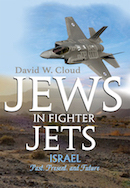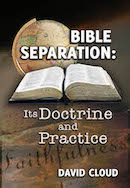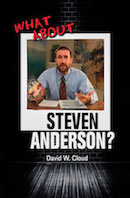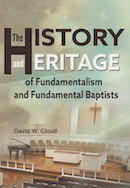866-295-4143, fbns@wayoflife.org

rthodoxy is that branch of sacramental Christianity which broke off from the Roman Catholic Church in 1054 A.D.
HISTORY
Until 1054 the Eastern and the Roman were two branches of the same sacramental body. The division began when the Roman emperor Constantine moved his capital from Rome to Constantinople in 330 A.D. Powerful church leaders claimed authority over large regions and were vying for supremacy. There was the bishop of Rome in the West, and four patriarchs in the East. The main point of contention between the eastern and the western divisions was the papacy. More important than doctrine was the issue of power and authority. The Eastern Orthodox rejected the pope, while retaining Rome’s sacramental system and most of Rome’s unscriptural doctrines.
“The division of the Orthodox Church into the Western and Eastern--Roman and Constantinople--began with the division of the Roman Empire in the late 4th century A.D. Toward the end of the 9th century the dialogue between the Papacy and the Patriarchate became much sharper: it was at that time that Bulgaria was baptised and an argument broke out between Rome and Constantinople over the patronage of the new Christian country. ... In 1054 there was a formal break between the Western (Roman) and Eastern (Orthodox) church when Pope Leo IX and Michael Caerularius, Patriarch of Constantinople, anathematised each other. This signified a formal split” (A Millennium of Russian Orthodoxy, pp. 20-21).
The Roman Catholic Church and its twin, Eastern Orthodoxy, were formed by a spiritually adulterous relationship between the political empire and apostate church leaders. The latter claimed authority over the Lord’s churches and amalgamated pagan practices with New Testament truth to form an impure form of Christianity. This explains the origin of such unscriptural practices as the mass, purgatory, sacraments, prayers to and for the dead, consecrated buildings, Mary worship, scapulars, and the rosary. Eastern Orthodoxy has its roots in this same apostasy.
Roman Catholicism and Eastern Orthodoxy both claim direct descent from Christ and the Apostles, but that this claim is bogus is evident in their non-apostolic doctrines and practices. As a result of the split with Rome, Eastern Orthodoxy is not united under one head. There are many groupings of Orthodox, all having the same basic doctrine and practice with some minor variation: Russian Orthodox, Albanian Orthodox, Syrian Orthodox, Ukrainian Orthodox, Bulgarian Orthodox, Romanian Orthodox, Serbian Orthodox, Antiochian Orthodox, etc. Though not united under a world headquarters, these groupings are united separately into episcopal councils, over which a bishop rules. Also, each group is in turn in formal relationship with the Patriarch of Constantinople, who presides over all the Eastern Orthodox churches. “No one patriarch is responsible to any other patriarch; yet all are within the jurisdiction of an ecumenical council of all the churches, in communion with the patriarch of Constantinople, who holds the title Ecumenical Patriarch” (Handbook). From a biblical perspective, there is little difference between the ecclesiology of Roman Catholicism and that of Eastern Orthodoxy. Both incorporate an unscriptural form of church government through which a intra-church bureaucracy lords over the local assembly.
GOSPEL AND DOCTRINE
Unlike Roman Catholicism, Orthodoxy rejects the papacy, purgatory, and the doctrine of indulgences.
Like Roman Catholicism, Orthodoxy has a consecrated priesthood and seven sacraments which only the priests have authority to perform--baptism, anointing, communion, penance, holy orders, marriage, and holy unction (Handbook of Denominations in the United States, 9th ed.).
It is by the sacraments that men are saved. They are “channels of grace” in contrast to the New Testament ordinances of baptism and the Lord’s Supper which are simple memorials and reminders.
In Orthodoxy, salvation begins with BAPTISM, which is called new birth.
“First place among the Sacraments of the Orthodox Church is occupied by Holy Baptism, by which a man, who has come to believe in Christ, by being immersed three times in water in the Name of the Holy Trinity (Father, Son and Holy Spirit), is cleansed through Divine Grace of all sins (Original Sin and personal sins) and is reborn into a new holy, and spiritual life. This Baptism serves as the door through which man enters into the House of Eternal Wisdom the Church for, without it, a man cannot be united completely with the Savior, become a member of His Church, receive the other Sacraments, and be the heir to Eternal Life” (These Truths We Hold - The Holy Orthodox Church: Her Life and Teachings, St. Tikhon's Monastery, copyright 1986 by the St. Tikhon's Seminary Press, South Canaan, Pennsylvania).
“Baptism is a new birth. It is being born to the life made new by our Lord Jesus Christ. It means to be alive in Christ. ... Through Holy Baptism all become Christ’s. We become Christians and have the opportunity to inherit God’s Kingdom. Why in the world would any parents who claim to be Christians want to put off making their offspring Christians as soon as possible? Don’t they want their infants to share in the Kingdom of God? The baptized one becomes a member of Christ’s body--His Church” (One Church, Russian Orthodox Church, 1981).
Salvation continues with “HOLY CHRISMATION,” which follows baptism and consists of anointing by an Orthodox priest. It is by this ritual that the Holy Spirit is supposedly given.
“In the Sacrament of Baptism man is called out of spiritual darkness into the light of Christ and is initiated into the economy of salvation by the Son of God. This initiation is effected, however, in the Sacrament of Chrismation. ... The Sacrament of Chrismation awakens in the soul that inner, spiritual thirst which does not let one grow satisfied solely with the earthly and material, but always summons us to the Heavenly, to the eternal and the perfect. It makes the baptized person the possessor of the Spirit bearing beauty and a partaker of sanctity, of the Unwaning Light and Divine Life. It is for this reason that in Chrismation the new member of the Church not only receives the Spirit within, but is outwardly encompassed by Him, being robed henceforth as if in special spiritual garments. ... In the Office of the Sacrament of Chrismation, the anointing is performed with the recitation of the words, The Seal of the Gift of the Holy Spirit, during which the Priest anoints crosswise with the Holy Chrism the forehead, eyes, nostrils, mouth, ears, breast, hands and feet of the Newly-illumined. After the anointing, the Priest then leads the Newly-illumined and sponsor (s) three times around the font to the singing of As many as have been baptized into Christ have put on Christ. Alleluia! This circular procession is seen as a symbol of joy” (These Truths We Hold - The Holy Orthodox Church: Her Life and Teachings, St. Tikhon's Monastery).
Salvation continues, then, with participation in the “HOLY COMMUNION” or “HOLY EUCHARIST,” whereby Christ supposedly is sacrificed anew and the bread and wine of the “eucharist” becomes the actual body and blood of Christ. This is the Orthodox form of the Catholic mass.
“We become part of the Mystical Body of Christ by our communion of the Holy Eucharist. ... Only by belonging to the Church, or in other words, being in communion with the very essence of Christ through the Sacrament of the Holy Eucharist, can one attain salvation unto eternal life, thus we can answer the question, Who can be regarded as a member of the Church of Christ? by saying, All those who have been properly baptized in the Name of the Father, Son and Holy Spirit, who believe in the Lord Jesus Christ as the true Son of God come in the flesh (1 John 4:2-3), and are united by the grace of the Sacraments in particular the Sacrament of the Holy Eucharist administered by the Priesthood of Apostolic Succession” (These Truths We Hold - The Holy Orthodox Church: Her Life and Teachings, St. Tikhon's Monastery).
“According to St. Nicholas Cabasilas, a medieval Orthodox teacher, the Church's understanding of the Eucharist is, as follows: In the first place, the sacrifice is not only an enactment or a symbol, but a real sacrifice. In the second, that which is sacrificed is not bread, but the very Body of Christ. In the third place, the Lamb of God was immolated only once and for all times. The Eucharist sacrifice consists not of the real or blood sacrifice of the Lamb, but in the transformation of bread into the sacrificed Lamb [Commentary on the Divine Liturgy, 32]. According to the Orthodox Church, then, the Eucharist is not just a reminder of Christ's sacrifice or of its enactment, but it is a real sacrifice” (These Truths We Hold - The Holy Orthodox Church: Her Life and Teachings, St. Tikhon's Monastery).
Orthodoxy “venerates” MARY as the “ever virgin” Mother of God.
“In the theology and piety of the Orthodox Church, a special place of honor is given to the Mother of God the Most-Holy Theotokos and Ever-Virgin Mary, who is reverenced by the Orthodox as being more honorable than the Cherubim and more glorious, beyond compare, than the Seraphim. ... If Mary is honored as Theotokos, so too, she is honored because she is Panagia All-Holy. ...Thus Mary is seen by the Church as the New Eve (as Christ is the New Adam) whose perfect obedience contrasted the disobedience of the First Mother, Eve, in Paradise. As St. Irenaeus says, the knot of Eve's disobedience was loosed through the obedience of Mary; for what Eve, a virgin, bound by her unbelief, that Mary, a virgin, unloosed by her faith [Against the Heresies, III, xxii, 4]. ... As All-Holy and Most-Pure, Mary was free from actual sin, but, in the opinion of most Orthodox theologians, although not dogmatized by the Church, she did fall under the curse of Original Sin as does all mankind. For this reason by virtue of her solidarity with all humanity the Theotokos died a bodily death. Yet, in her case, the resurrection of the body had been anticipated; and she was assumed body and soul into Heaven; and her tomb was found empty an event celebrated in the Feast of the Falling-Asleep (or Dormition) of the Most-Holy Theotokos (Aug. 15). Thus, as the hymns of that Feast proclaim, she has passed from earth to heaven, beyond death and judgment, living already in the age to come. She enjoys now the same bodily glory all of us hope to share one day” (These Truths We Hold - The Holy Orthodox Church: Her Life and Teachings, St. Tikhon's Monastery).
PRAYERS ARE OFFERED FOR THE DEAD, who also are believed to pray for those on earth.
“At every Divine Service, the Holy Orthodox Church offers up prayers for her departed children” (St. Nektarios Church, Charlotte, North Carolina).
“But the soul of the deceased is aided by the prayers of the Church, of all those who knew and loved him, and also by acts of charity carried out for his sake. By doing good works for the sake of those who are dead, we are, as it were, completing what they left undone, paying their debts and offering our own sacrifice to the Merciful Lord on their behalf” (The Journal of the Moscow Patriarchate, No. 10, 1976).
As in Roman Catholicism, Orthodoxy exalts its own TRADITION to a place of authority equal to that of Scripture.
“To an Orthodox Christian, Tradition means the Holy Bible; it means the Creed; it means the decrees of the Ecumenical Councils and the writings of the Fathers; it means the Canons, the Service Books, the Holy Icons, etc. In essence, it means the whole system of doctrine, ecclesiastical government, worship and art which Orthodoxy has articulated over the ages” (Timothy Ware, The Orthodox Church, p. 204).
“We take special note that for the Orthodox, the Holy Bible forms apart of Holy Tradition, but does not lie outside of it. One would be in error to suppose that Scripture and Tradition are two separate and distinct sources of Christian Faith, as some do, since there is, in reality, only one source; and the Holy Bible exists and found its formulation within Tradition” (These Truths We Hold - The Holy Orthodox Church: Her Life and Teachings, St. Tikhon's Monastery).
MEMBERSHIP
In 1990 there were an estimated three million Orthodox church members in the United States, though membership statistics are unreliable due to the fact that they are based on baptismal records rather than active participation in church life. A 1987 report estimated 173 million Orthodox worldwide, but again, this statistic is almost meaningless in relation to how many adults actually practice the Orthodox faith.
ECUMENISM
The Eastern Orthodox churches are members of and form an influential block within the World Council of Churches. In recent years steps have also been taken to reconcile the Eastern Orthodox with the Roman Catholic Church. In 1965 Pope Paul VI and Patriarch Athenagoras I formally lifted the excommunications of 1054.
- Receive these reports by email
- www.wayoflife.org
______________________
Sharing Policy: Much of our material is available for free, such as the hundreds of articles at the Way of Life web site. Other items we sell to help fund our expensive literature and foreign church planting ministries. Way of Life's content falls into two categories: sharable and non-sharable. Things that we encourage you to share include the audio sermons, O Timothy magazine, FBIS articles, and the free eVideos and free eBooks. You are welcome to make copies of these at your own expense and share them with friends and family. You may also post parts of reports and/or entire reports to websites, blogs, etc as long as you give proper credit (citation). A link to the original report is very much appreciated as the reports are frequently updated and/or expanded. Things we do not want copied and distributed are "Store" items like the Fundamental Baptist Digital Library, print editions of our books, electronic editions of the books that we sell, the videos that we sell, etc. The items have taken years to produce at enormous expense in time and money, and we use the income from sales to help fund the ministry. We trust that your Christian honesty will preserve the integrity of this policy. "For the scripture saith, Thou shalt not muzzle the ox that treadeth out the corn. And, The labourer is worthy of his reward" (1 Timothy 5:18). Questions? support@wayoflife.org
Goal:Distributed by Way of Life Literature Inc., the Fundamental Baptist Information Service is an e-mail posting for Bible-believing Christians. Established in 1974, Way of Life Literature is a fundamental Baptist preaching and publishing ministry based in Bethel Baptist Church, London, Ontario, of which Wilbert Unger is the founding Pastor. Brother Cloud lives in South Asia where he has been a church planting missionary since 1979. Our primary goal with the FBIS is to provide material to assist preachers in the edification and protection of the churches.
Offering: Offerings are welcome if you care to make one. If you have been helped and/or blessed by our material offerings can be mailed or made online with with Visa, Mastercard, Discover, or Paypal. For information see: www.wayoflife.org/about/makeanoffering.html.





